Half a century after a notorious prison escape from Alcatraz Island, the FBI has created replicas of decoy heads that inmates used to distract guards from a plan that still captivates researchers and tourists.
Authorities on Thursday unveiled 3D-printed copies of the decoys that inmates Frank Morris and John and Clarence Anglin constructed with soap, plaster and human hair.
Click to Gallery
Half a century after a notorious prison escape from Alcatraz Island, the FBI has created replicas of decoy heads that inmates used to distract guards from a plan that still captivates researchers and tourists.
Inmate Clayton West also created a head but never made it out of the maximum-security prison that housed dangerous criminals like Al Capone and offenders with a history of escaping.
Bennett said a team from the FBI's laboratory in Quantico, Virginia, traveled to San Francisco to scan the original decoys. Employees at the lab donated their own hair to accurately re-create the original masks, which included human hair that the inmates had collected from the prison barber shop.
Now, Alcatraz visitors can see models of the heads on display that were used in the movie. The FBI hopes the public will soon be able to view the agency's replicas, which were unveiled to some media outlets along with "Wanted" signs for the long-escaped inmates.
Shown is the area that prisoners climbed behind their cells to reach a rooftop and mount their famous 1962 escape from Alcatraz Island Thursday, Nov. 15, 2018, in San Francisco. The FBI has created replicas of decoy heads used by prisoners to mount their infamous escape from Alcatraz. Authorities on Thursday unveiled 3D printed replicas of the decoys that inmates had constructed with soap, plaster and human hair to distract guards from their plan. Authorities say inmates Frank Morris and John and Clarence Anglin placed the decoys in their beds before climbing through the wall to escape the island prison in San Francisco Bay. The men were never found. (AP PhotoEric Risberg)
FBI agents carry waterproof cases containing newly 3d printed decoy heads, used to mount a famous prison escape in 1962, to a news conference on Alcatraz Island Thursday, Nov. 15, 2018, in San Francisco. The FBI has created replicas of decoy heads used by prisoners to mount their infamous escape from Alcatraz. Authorities on Thursday unveiled 3D printed replicas of the decoys that inmates had constructed with soap, plaster and human hair to distract guards from their plan. Authorities say inmates Frank Morris and John and Clarence Anglin placed the decoys in their beds before climbing through the wall to escape the island prison in San Francisco Bay. The men were never found. (AP PhotoEric Risberg)
FBI Special Agent in Charge John F. Bennett speaks about the unveiling of new 3D printed decoy heads used in a famous 1962 prison escape during a news conference on Alcatraz Island Thursday, Nov. 15, 2018, in San Francisco. The FBI has created replicas of decoy heads used by prisoners to mount their infamous escape from Alcatraz Island in 1962. Authorities on Thursday unveiled 3D printed replicas of the decoys that inmates had constructed with soap, plaster and human hair to distract guards from their plan. Authorities say inmates Frank Morris and John and Clarence Anglin placed the decoys in their beds before climbing through the wall to escape the island prison in San Francisco Bay. The men were never found. (AP PhotoEric Risberg)
Morris and the Anglin brothers placed the decoys in their beds and climbed through a wall to escape the island prison in San Francisco Bay. The men were never found.
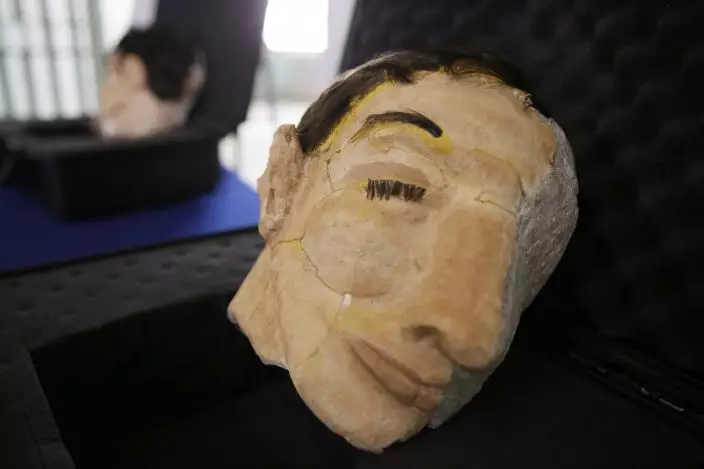
A newly 3D printed decoy head used by prisoners to mount their infamous escape in 1962, is on display during a news conference at Alcatraz Island Thursday, Nov. 15, 2018, in San Francisco. The FBI has created replicas of decoy heads used by prisoners to mount their infamous escape from Alcatraz. Authorities on Thursday unveiled 3D printed replicas of the decoys that inmates had constructed with soap, plaster and human hair to distract guards from their plan. Authorities say inmates Frank Morris and John and Clarence Anglin placed the decoys in their beds before climbing through the wall to escape the island prison in San Francisco Bay. The men were never found. (AP PhotoEric Risberg)
Inmate Clayton West also created a head but never made it out of the maximum-security prison that housed dangerous criminals like Al Capone and offenders with a history of escaping.
Authorities said they made the replicas to share with the public because the original decoys are fragile and are evidence in the still-open investigation into the escape by the U.S. Marshals Service.
"We understand the original items can't be out here — they've got to be archived," said John F. Bennett, FBI special agent in charge in San Francisco. "But we recognize that those items are also part of the rich and historic fabric and the landmark of this city."
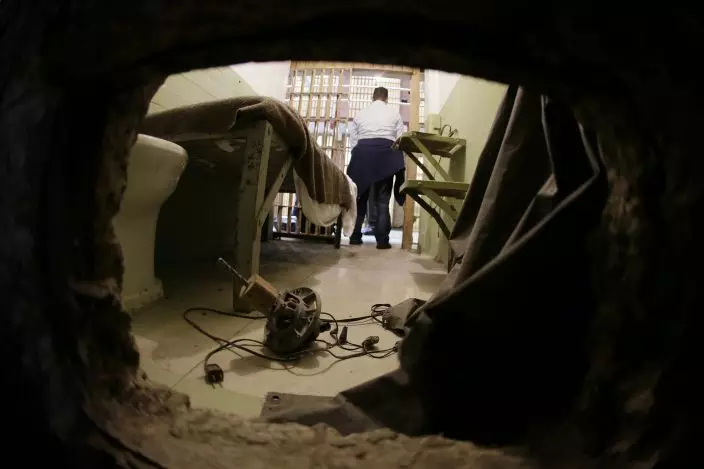
Through this hole cut into the back of a prison cell is the way one of three prisoners mounted a famous 1962 escape, on Alcatraz Island Thursday, Nov. 15, 2018, in San Francisco. The FBI has created replicas of decoy heads used by prisoners to mount their infamous escape from Alcatraz Island in 1962. Authorities on Thursday unveiled 3D printed replicas of the decoys that inmates had constructed with soap, plaster and human hair to distract guards from their plan. Authorities say inmates Frank Morris and John and Clarence Anglin placed the decoys in their beds before climbing through the wall to escape the island prison in San Francisco Bay. The men were never found. (AP PhotoEric Risberg)
Bennett said a team from the FBI's laboratory in Quantico, Virginia, traveled to San Francisco to scan the original decoys. Employees at the lab donated their own hair to accurately re-create the original masks, which included human hair that the inmates had collected from the prison barber shop.
"The hair and the paint on here is exactly what the prisoners did," Bennett said, showing the replicas brought to the island in black, waterproof cases.
The FBI investigated the prison break — which was featured in the 1979 movie "Escape from Alcatraz" starring Clint Eastwood — for 17 years before it was turned over to the Marshals Service.
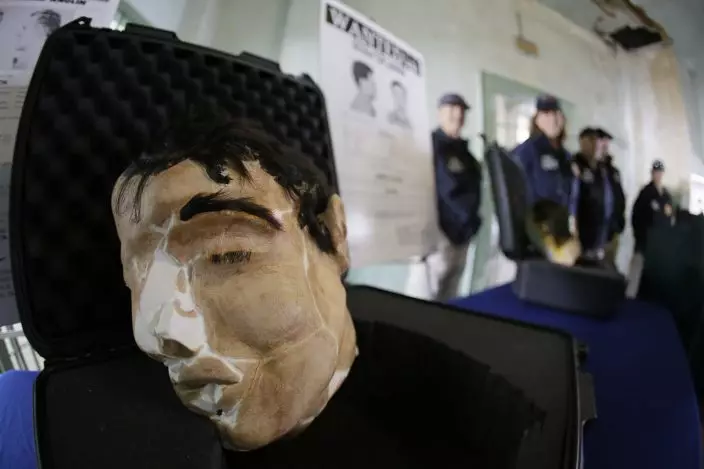
A newly 3D printed decoy head used by prisoners to mount their infamous escape in 1962, is on display as FBI agents looks on before the start of a news conference at Alcatraz Island Thursday, Nov. 15, 2018, in San Francisco. The FBI has created replicas of decoy heads used by prisoners to mount their infamous escape from Alcatraz. Authorities on Thursday unveiled 3D printed replicas of the decoys that inmates had constructed with soap, plaster and human hair to distract guards from their plan. Authorities say inmates Frank Morris and John and Clarence Anglin placed the decoys in their beds before climbing through the wall to escape the island prison in San Francisco Bay. The men were never found. (AP PhotoEric Risberg)
Now, Alcatraz visitors can see models of the heads on display that were used in the movie. The FBI hopes the public will soon be able to view the agency's replicas, which were unveiled to some media outlets along with "Wanted" signs for the long-escaped inmates.
Authorities are investigating any and all credible leads, said Don O'Keefe, U.S. marshal for the Northern District of California.
"Some may believe that we're chasing shadows, but our efforts are meant not just to perform due diligence, but to be a warning to other fugitives, that U.S. Marshals don't give up because of the passing of time," he said in a statement.
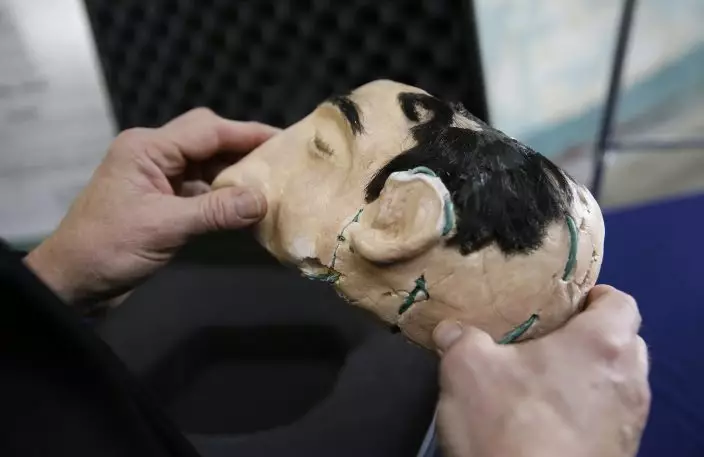
FBI Special Agent in Charge John F. Bennett examines a newly 3D printed decoy head used in a famous 1962 prison escape during a news conference on Alcatraz Island Thursday, Nov. 15, 2018, in San Francisco. The FBI has created replicas of decoy heads used by prisoners to mount their infamous escape from Alcatraz Island in 1962. Authorities on Thursday unveiled 3D printed replicas of the decoys that inmates had constructed with soap, plaster and human hair to distract guards from their plan. Authorities say inmates Frank Morris and John and Clarence Anglin placed the decoys in their beds before climbing through the wall to escape the island prison in San Francisco Bay. The men were never found. (AP PhotoEric Risberg)
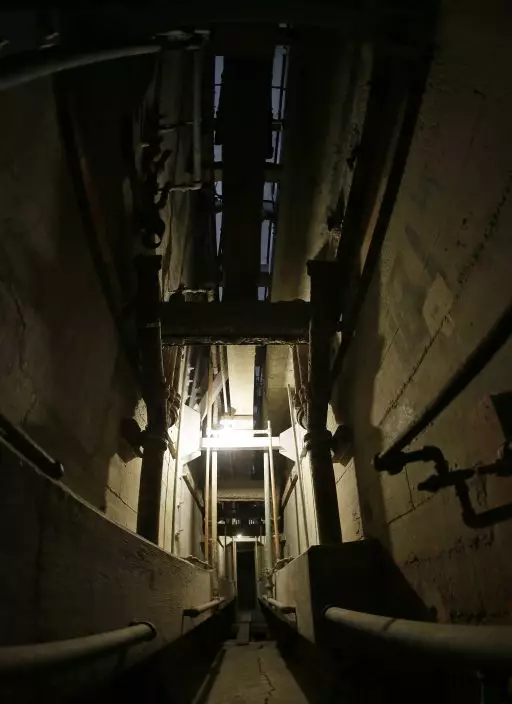
Shown is the area that prisoners climbed behind their cells to reach a rooftop and mount their famous 1962 escape from Alcatraz Island Thursday, Nov. 15, 2018, in San Francisco. The FBI has created replicas of decoy heads used by prisoners to mount their infamous escape from Alcatraz. Authorities on Thursday unveiled 3D printed replicas of the decoys that inmates had constructed with soap, plaster and human hair to distract guards from their plan. Authorities say inmates Frank Morris and John and Clarence Anglin placed the decoys in their beds before climbing through the wall to escape the island prison in San Francisco Bay. The men were never found. (AP PhotoEric Risberg)

FBI agents carry waterproof cases containing newly 3d printed decoy heads, used to mount a famous prison escape in 1962, to a news conference on Alcatraz Island Thursday, Nov. 15, 2018, in San Francisco. The FBI has created replicas of decoy heads used by prisoners to mount their infamous escape from Alcatraz. Authorities on Thursday unveiled 3D printed replicas of the decoys that inmates had constructed with soap, plaster and human hair to distract guards from their plan. Authorities say inmates Frank Morris and John and Clarence Anglin placed the decoys in their beds before climbing through the wall to escape the island prison in San Francisco Bay. The men were never found. (AP PhotoEric Risberg)

FBI Special Agent in Charge John F. Bennett speaks about the unveiling of new 3D printed decoy heads used in a famous 1962 prison escape during a news conference on Alcatraz Island Thursday, Nov. 15, 2018, in San Francisco. The FBI has created replicas of decoy heads used by prisoners to mount their infamous escape from Alcatraz Island in 1962. Authorities on Thursday unveiled 3D printed replicas of the decoys that inmates had constructed with soap, plaster and human hair to distract guards from their plan. Authorities say inmates Frank Morris and John and Clarence Anglin placed the decoys in their beds before climbing through the wall to escape the island prison in San Francisco Bay. The men were never found. (AP PhotoEric Risberg)
KYIV, Ukraine (AP) — A big, new package of U.S. military aid will help Ukraine avoid defeat in its war with Russia. Winning will still be a long slog.
The arms and ammunition in the $61 billion military aid package should enable Ukraine to slow the Russian army's bloody advances and block its strikes on troops and civilians. And it will buy Ukraine time — for long-term planning about how to take back the fifth of the country now under Russian control.
“Ultimately it offers Ukraine the prospect of staying in the war this year,” said Michael Clarke, visiting professor in war studies at King’s College London. “Sometimes in warfare you’ve just got to stay in it. You’ve just got to avoid being rolled over.”
The U.S. House of Representatives approved the package on Saturday after months of delays by some Republicans wary of U.S. involvement overseas. It was passed by the Senate on Tuesday, and President Joe Biden said he would sign it Wednesday.
The difference could be felt within days on the front line in eastern and southern Ukraine, where Russia’s much larger army has been slowly taking territory against massively outgunned Ukrainian forces.
The aid approval means Ukraine may be able to release artillery ammunition from dwindling stocks that it has been rationing. More equipment will come soon from American stocks in Poland and Germany, and later from the U.S.
The first shipments are expected to arrive by the beginning of next week, said Davyd Arakhamia, a lawmaker with Ukrainian President Volodymyr Zelenskyy’s Servant of the People party.
But opposition lawmaker Vadym Ivchenko, a member of the Ukrainian parliament’s National Security, Defense and Intelligence Committee, said logistical challenges and bureaucracy could delay shipments to Ukraine by two to three months, and it would be even longer before they reach the front line.
While details of the shipments are classified, Ukraine’s most urgent needs are artillery shells to stop Russian troops from advancing, and anti-aircraft missiles to protect people and infrastructure from missiles, drones and bombs.
What’s coming first is not always what front-line commanders need most, said Arakhamia, the Ukrainian lawmaker. He said that even a military giant like the U.S. does not have stockpiles of everything.
“The logic behind this first package was, you (the U.S.) finds our top priorities and then you see what you have in the warehouses,” Arakhamia said. “And sometimes they do not match.”
Hope for future breakthroughs for Ukraine still hangs on more timely deliveries of Western aid, lawmakers acknowledge.
Many experts believe that both Ukraine and Russia are exhausted by two years of war and won’t be able to mount a major offensive — one capable of making big strategic gains — until next year.
Still, Russia is pushing forward at several points along the 1,000-kilometer (600-mile) front, using tanks, wave after wave of infantry troops and satellite-guided gliding bombs to pummel Ukrainian forces. Russia is also hitting power plants and pounding Ukraine’s second-largest city, Kharkiv, which is only about 30 kilometers (some 20 miles) from the Russian border.
Ivchenko said the goal for Ukraine’s forces now is to “hold the line” until the bulk of new supplies arrive by mid-summer. Then, they can focus on trying to recapture territory recently lost in the Donetsk region.
“And probably ... at the end of summer we’ll see some movement, offensive movement of the Ukrainian armed forces,” he said.
Some military experts doubt Ukraine has the resources to mount even small offensives very soon.
The U.S. funding “can probably only help stabilize the Ukrainian position for this year and begin preparations for operations in 2025,” said Matthew Savill, director of military sciences at the Royal United Services Institute, a think tank.
In the best-case scenario for Ukraine, the American aid will give commanders time to reorganize and train its army — applying lessons learned from its failed summer 2023 offensive. It may also galvanize Ukraine’s allies in Europe to increase aid.
“So this just wasn’t about Ukraine and the United States, this really affected our entire 51-country coalition,” said U.S. Congressman Bill Keating, a Democrat who visited Kyiv on Monday as part of a four-member congressional delegation.
Zelenskyy insists Ukraine's war aim is to recapture all its territory from Russia — including Crimea, seized illegally in 2014. Even if the war ultimately ends through negotiation, as many experts believe, Ukraine wants to do that from as strong a position as possible.
Whatever happens on the battlefield, Ukraine still faces variables beyond its control.
Former U.S. President Donald Trump, who seeks to retake the White House in the November election, has said he would end the war within days of taking office. And the 27-nation Europe Union includes leaders like Hungarian Prime Minister Viktor Orbán and Slovak Prime Minister Robert Fico, who have opposed arming Ukraine.
Ukraine’s allies have held back from supplying some arms out of concern about escalation or depleting their own stocks. Ukraine says that to win the war it needs longer-range missiles it could use for potentially game-changing operations such as cutting off occupied Crimea, where's Russia's Black Sea fleet is based.
It wants Army Tactical Missile Systems, known as ATACMs, from the U.S. and Taurus cruise missiles from Germany. Both governments have resisted calls to send them because they are capable of striking targets deep within Russian territory.
The new bill authorizes the president to send Ukraine ATACMS “as soon as practicable.” It's unclear what that will mean in practice.
Sometimes, promised weapons have arrived late, or not at all. Zelenskyy recently pointed out that Ukraine is still waiting for the F-16 fighter jets it was promised a year ago.
Meanwhile, Russia is using its advantage in troops and weapons to push back Ukrainian forces, perhaps seeking to make maximum gains before Ukraine's new supplies arrive.
For weeks it has pummeled the small eastern city of Chasiv Yar, at the cost of 900 soldiers killed and wounded a day, according to the U.K. Ministry of Defense.
Capturing the strategically important hill town would allow them to move toward Sloviansk and Kramatorsk, key cities Ukraine controls in the eastern region of Donetsk. It would be a significant win for Russian President Vladimir Putin, who Western officials say is bent on toppling Ukraine’s pro-Western government.
Russian pressure was aimed not just at gaining territory, but on undermining Zelenskyy and bolstering critics who say his war plan is failing, said Clarke of King's College London.
The U.S. aid package decreases the likelihood of a political crisis in Ukraine, and U.S. Speaker Mike Johnson deserves credit for pushing it through Congress, he said.
"He held history in his hands,” Clarke said.
Follow AP’s coverage of the war in Ukraine at https://apnews.com/hub/russia-ukraine

From left, U.S. representatives Nathaniel Moran, R-Tx, Tom Kean Jr, R-NJ, Bill Keating, D-Mass, and Madeleine Deane, D-Pa, talk to journalists during a joint news conference outside Saint Michael cathedral in Kyiv, Ukraine, Monday, April 22, 2024. A newly approved package of $61 billion in U.S. aid may prevent Ukraine from losing its war against Russia. But winning it will be a long slog. (AP Photo/Francisco Seco)
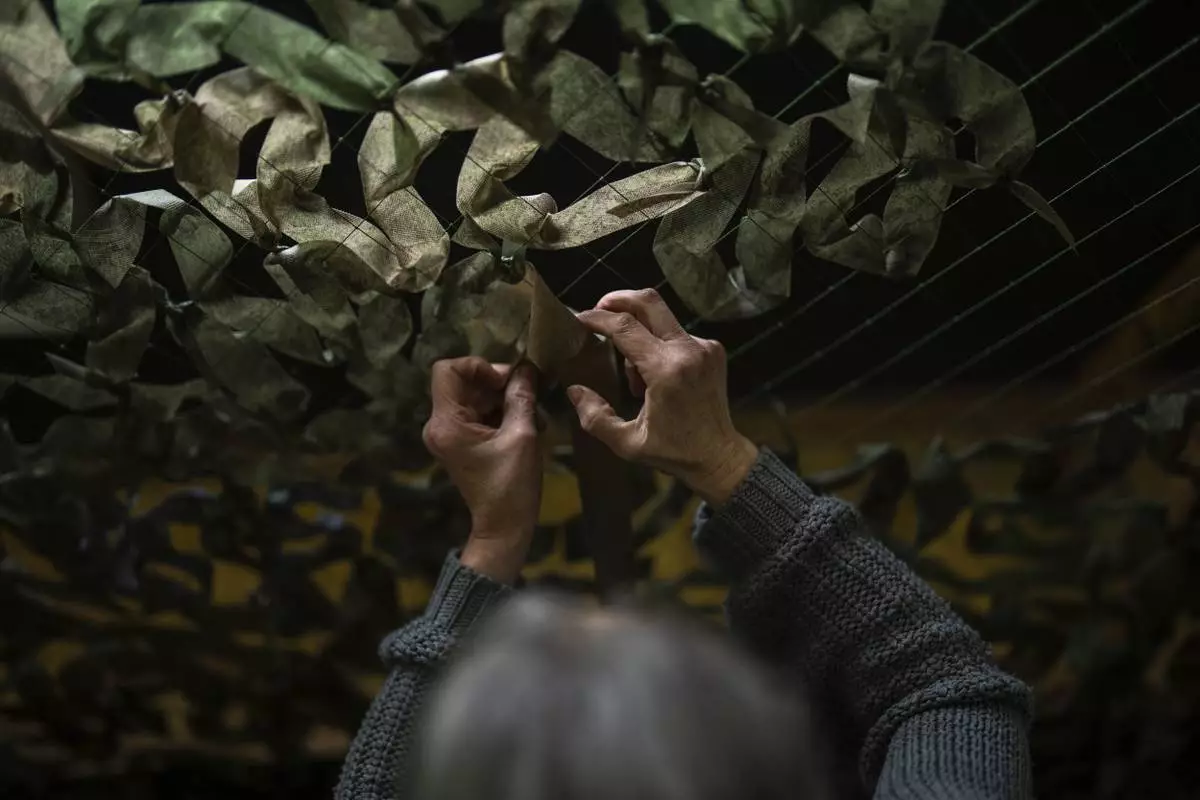
A volunteer makes a camouflage net at a facility producing material for Ukrainian soldiers in Kyiv, Ukraine, Monday, April 22, 2024. A newly approved package of $61 billion in U.S. aid may prevent Ukraine from losing its war against Russia. But winning it will be a long slog. (AP Photo/Francisco Seco)

Davyd Arakhamia, a lawmaker with Ukrainian President Volodymyr Zelenskyy's Servant of the People party, talks during an interview with Associated Press in Kyiv, Ukraine, Monday, April 22, 2024. (AP Photo/Francisco Seco)

A woman rallies to raise awareness on the fate of Ukrainian prisoners of war in Kyiv, Ukraine, Sunday, April 21, 2024. (AP Photo/Francisco Seco)
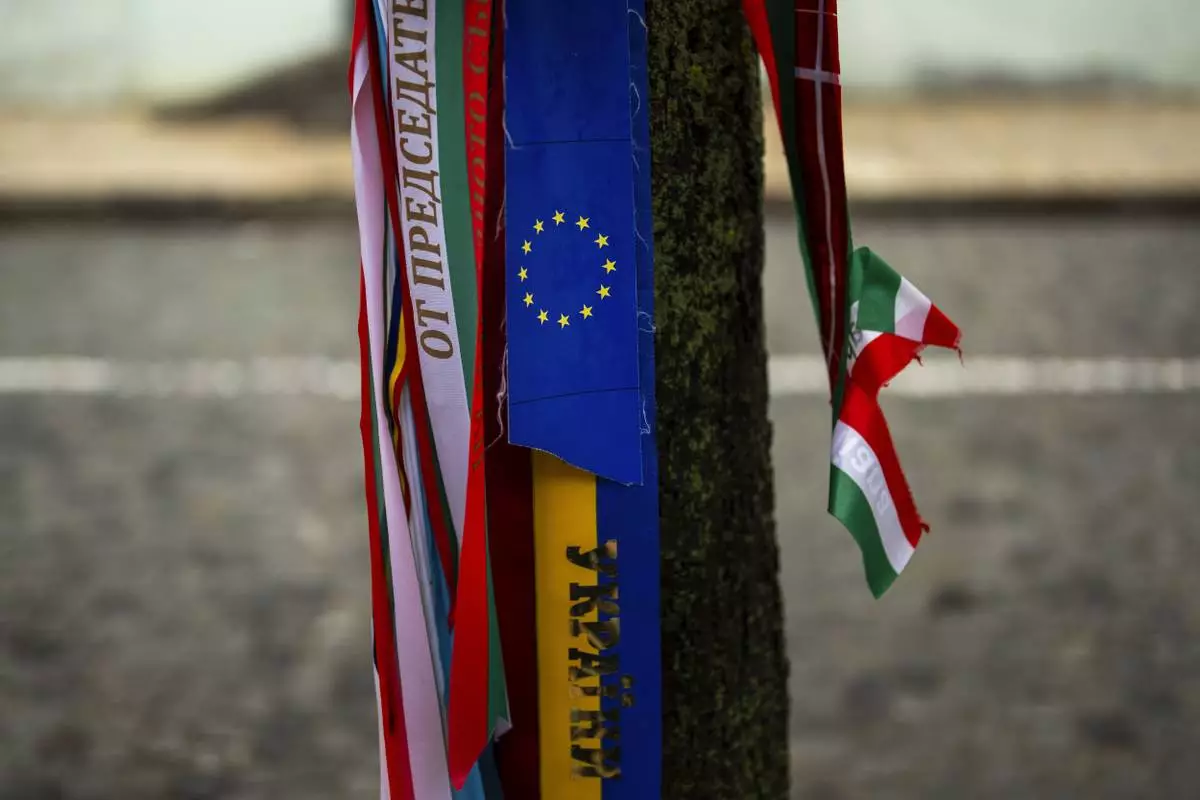
Ribbons with the colors of the European Union and Ukraine are attached to a tree next to memorial wall of Ukrainian soldiers killed during the war in Kyiv, Ukraine, Monday, April 22, 2024. (AP Photo/Francisco Seco)
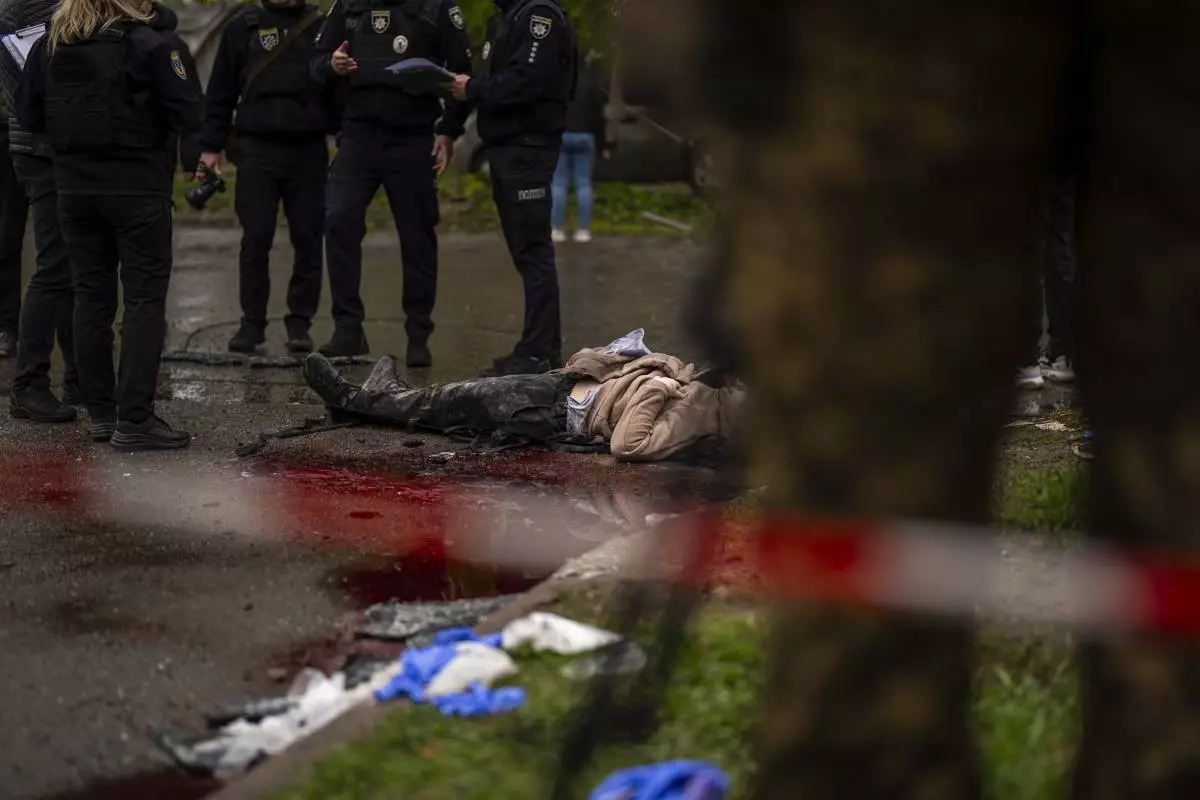
The body of a woman killed by Russian bombardment in Chernihiv, Ukraine, Wednesday, April 17, 2024. (AP Photo/Francisco Seco)

Soldiers carry the coffins of two Ukrainian army sergeants during their funeral in Lviv, Ukraine, Tuesday, April 16, 2024. (AP Photo/Francisco Seco)























